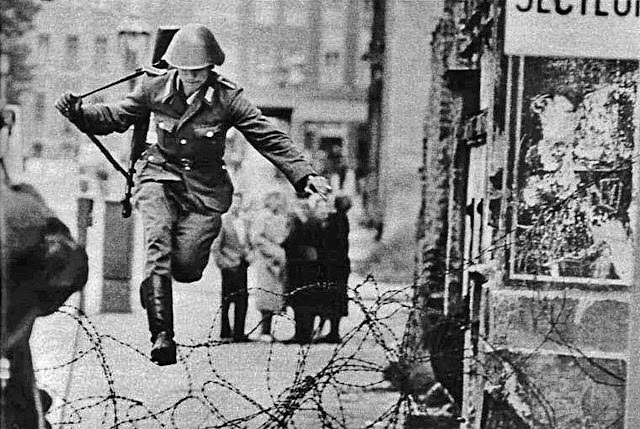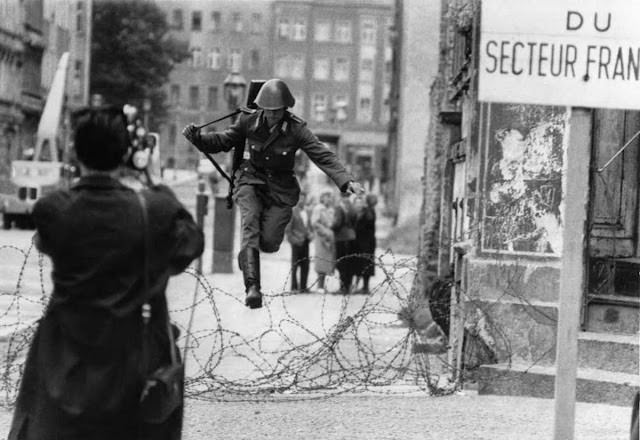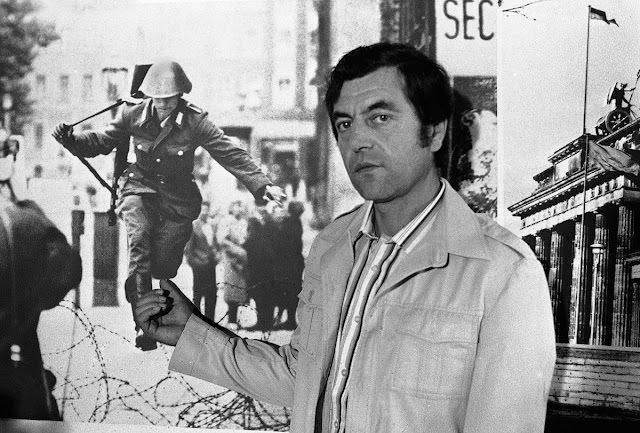In the annals of Cold War history, few images are as poignant and powerful as the one of East German soldier, Conrad Schumann, in mid-flight over barbed wire, leaping towards freedom from East Berlin. Taken on August 15, 1961, this photograph remains one of the most famous images from the era, embodying the human spirit’s thirst for freedom. To fully appreciate this iconic photograph, let’s delve into the compelling backstory and understand the man who dared to leap.

Conrad Schumann: The Man Behind the Uniform
Born in Zschochau, East Germany in 1942, Conrad Schumann was just a teenager when he was conscripted into the East German border guard. He was among the thousands of soldiers tasked with the grim responsibility of securing the border and preventing fellow citizens from escaping to the West. Yet, even as he stood guard, Schumann was internally battling his growing disillusionment with the oppressive regime.
The Fateful Day
On August 15, 1961, Schumann found himself stationed at a relatively low barricade of barbed wire on the corner of Bernauer Strasse and Ruppiner Strasse. The full-scale Berlin Wall was yet to be constructed, and the barrier that would eventually become an imposing symbol of division was still a manageable hurdle.
It was on this day that a young photographer named Peter Leibing, sensing an opportunity for a significant moment, arrived on the scene. As Leibing trained his lens on Schumann, he couldn’t have known that he was about to capture a moment that would resonate globally and etch itself into the annals of Cold War history.
The atmosphere was fraught with tension. West Berliners had gathered on the other side of the barrier, their chants of “Komm rüber!” – “Come over!” – hanging in the air. Schumann, his heart pounding, made his decision. He dropped his submachine gun, sprinted towards the wire, and in one fluid motion, leapt over the barrier to freedom. His daring escape was captured in a photograph that would soon become iconic.

The Leap That Echoed Around the World
The photograph of Schumann’s leap is a freeze-frame of a profoundly personal and historic moment. His body is taut and his gaze focused, revealing the determination driving his flight towards freedom. His discarded gun on the ground symbolized his rejection of the regime he had served, while his white sneakers, captured mid-air, spoke to the youth and audacity of his daring move.
This image rapidly circulated around the world, capturing the attention and imagination of millions. It encapsulated the grim reality of the divided city, the stark political contrasts of the Cold War, and the lengths individuals would go to for freedom. This picture would eventually become a symbol of defiance against oppressive regimes worldwide.
The Aftermath: A New Life and Lasting Legacy
Schumann’s leap was not the end, but rather the beginning of a new, complicated chapter in his life. The West Berlin police quickly escorted him to safety, protecting him from immediate retaliation. He was given a new identity and eventually moved to Bavaria, where he started a new life, working for the car manufacturer, Audi, and raising a family.

However, freedom came with its own set of challenges. Schumann lived under the constant shadow of his past. He was often haunted by guilt for leaving his family and friends behind, and the pressure of his unexpected fame weighed heavily on him. Despite finding physical freedom, mental and emotional freedom would only come after the Berlin Wall fell in 1989.
Schumann passed away in 1998, but his legacy endures through the iconic photograph and the indelible mark his leap left on the Cold War’s history. The photograph continues to inspire and remind future generations of the power of individual acts of defiance in the face of oppression.


